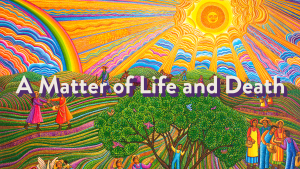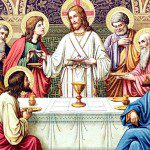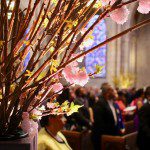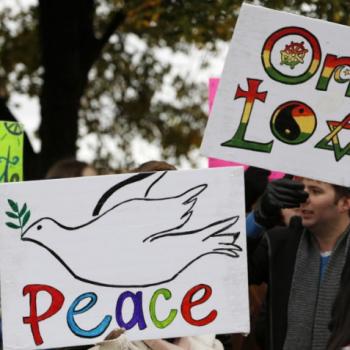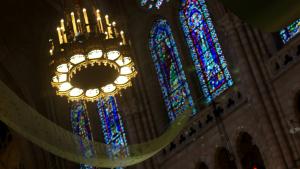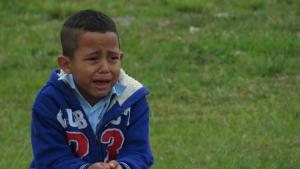Christ is risen!
Christ is risen, indeed!
In America and Great Britain in the 18th and 19th centuries, there was a little-known but thriving community of professionals known as “the resurrectionists.”
With the advent of modern medical schools, the study of human anatomy and medicine required actual human bodies be available for dissection and study, but it seems nobody was interested in donating a body to science back then. Without a steady supply of bodies to study, the thriving schools had to turn to black market professionals, grave robbers, “the resurrectionists,” who would seek out newly buried bodies, steal them, and sell them to medical schools for profit.
This happened a lot, scholars say. And you can imagine the public outcry. People were rightly concerned that they’d grieve the death of a loved one and attend services during which the body of their loved one was buried, only to return to the grave the next day and find an empty hole in the ground.
It’s shocking, this industry built on disregard for the final resting places of the dead. But what I found even more notable as I read about the resurrectionists is the length to which people went to keep their loved ones in their graves.
Poorer families would set booby traps that would go off if the grave was tampered with. Iron fences were installed around many burial grounds as deterrents to the resurrectionists, and yet another industry emerged: the manufacture and sale of “burglar proof grave vaults made of steel,” sold with the promise that loved ones’ remains would stay in the ground forever.
You can’t blame them, really. After all, we are surrounded with the reality of death, mesmerized by the eventuality and the finality of the end of life. It’s so commonplace to us, so inevitable, that we often find ourselves living into its expectation. We need the dead to stay dead, the grave to be just as we expect to find it. But soon we find that it’s a fear of death that begins to define our very living.
Even just this week we’ve been hearing stories of denial and death: political intrigue, dear friends betraying each other, violence perpetrated without thought, the building of a huge monument to power and exclusion, executions planned over the dinner table, the unimaginable suffering of innocents, the powerful resorting to violence to remind the world that they can cause death, and they will…if it gets them what they want.
And that was just the news this week from the Washington!
The story of Holy Week the last week of Jesus’ life and the story of Holy Week in America in 2017 share this one, stark truth: we are sucked in by violence, hypnotized by terror, manipulated by fear, mesmerized by death. We can’t seem to give it up, to let go of the constant, cyclical grinding of the human reality. Fear, violence, death; fear, violence, death; fear, violence, death.
But today is Easter. And if the constant, cyclical decay of our human life narrates our living on other days, today it must not, because today is about…resurrection. Today we think about life, and all the possibilities that begin to emerge when make a choice that is a matter of life and death…a choice to reject a narrative of fear and choose instead to claim for ourselves and for our world, a new narrative: one that does not keep us chained in steel coffins, allowing the fear of death to rule our lives. But opens us up, instead, to faith. To resurrection.
All of the gospel writers include some version of the resurrection story, and we Easter church attenders have heard all of them over the years. Today we’ve been given Matthew’s telling.
It had been a harrowing week, filled with fear. All of Jesus’ friends had been gathered for Passover celebration only one week before, and the events of the intervening days seemed numbingly unending and punctuated with pain. First Jesus was betrayed by his dear friend, turned over to the authorities because he wanted the money, but we all know it was really because of fear.
Then Jesus was dragged before a sycophant governor, Pilate, who was too concerned with his own reputation, with staying out of trouble, and with making Jerusalem great again, that he washed his hands, quite literally, of the horror around him and gave into arrogance, which was really, as we know, fear.
Then Jesus’ friends watched him beaten, dragged up a hill, crucified, killed. One by one they fell away, too worried about their own safety, too calculating with regard to their political positions, too mesmerized with death themselves, which was—as we all know—fear. Fear.
Then, when the sky suddenly went dark, the women stumbled up the hill behind their friend Jesus. He was the one carrying the heavy, heavy cross, his broken body struggling up the hill toward the place of the skull, but as they followed him up the hill they felt as if they, too, were carrying a heavy, punishing burden. No heavy cross for them; instead, it was fear, dread, really, that was weighing them down, pressing on their shoulders, tripping up their feet.
And the women stayed. They stayed as night fell and Joseph of Arimathea, with permission from Roman authorities, came and took Jesus’ body down. They were even there, Matthew tells us, when Jesus’ lifeless body was placed in the tomb and a huge rock was rolled over the entrance. Roman guards came to watch, to make sure no one stole the body, and the women turned to leave, their shoulders sagging with the weight of everything they’d seen and heard, all the hopelessness and horror that made them weep—weep with all the pain and despair of the loudest human lament ever heard, which rose out of their throats, as we know, because of fear.
All of them, kept prisoner by so much fear. And night fell, and the darkness settled, and it seemed that all life had to offer was death and endings, over and over and over.
But the next morning, two of them made their way back to the tomb. They came across a gleaming angel sitting on a rock, two guards almost literally scared to death, and an invitation to take a step toward the empty tomb that represented new life. And when they were greeted with the words, “Do not be afraid!,” they had a choice to make. Would they choose fear, as so many others had? Or will they choose faith? Love?
It wasn’t just an afterthought, the invitation to choose that day; it was, in fact, a matter of life and death. If you come to the tombs of your life thinking you’re going to find death that’s one thing, but if you come hoping to find the risen Lord that’s another altogether. Maybe, just maybe, these women had taken Jesus at his word. Maybe they had come not to give Jesus a proper burial, but to get a front row seat for his resurrection.
And if that’s true then they were not disappointed.
What would happen if we made a choice like the women at the tomb that day? What if we refused to give into the narrative of fear? It would be so very hard, for we are people who live in the rational world, where grief colors our human experience, where failure and endings punctuate our lives, where death is a harsh reality, where, in fact, we are so trapped by fear we will do anything to keep things as we expect. The people in this story who were tripped up by fear, locked in by death, had placed their bets on a world they had mastered–a world of political power or military might or religious privilege and authority, all fueled by large sums of money.
But Easter made it clear that none of those visible sources of power had been enough to keep Jesus dead and buried, and their world within their control. They couldn’t foil the divine Resurrectionist; they couldn’t keep a dead person in the ground, no matter how hard they tried. And neither can we.
In a world full of fake news, it is about time for some good news, and here it is: we have a choice. When we look around us, we are mesmerized by death, determined to keep things just as they are because we’re afraid, but on Easter we stop looking into the hypnotic gaze of fear and consider the possibility of choosing faith instead. We have a choice! Which one will it be?
We must choose faith because it gives our religion hands and feet in a world that needs the healing love of the gospel message. When we choose fear our religion becomes impotent; we are people of dusty books and antiquated sayings and wishful thinking.
We must choose faith because people we love have died, but sometimes when death takes them it also robs us of a life lived with intention. Immobilized by fear, we spend our time hanging onto fading memories and wishing for what was or what could have been.
We must choose faith because living within the structures of this world that paint bleak futures for young men of color and welcome violence against women and kill our precious planet one degree of the thermometer at a time…those structures dry our spirits and shrivel our hearts, we throw up our hands in fear and desperation, and we turn against each other because there seems to be no other way.
We must choose faith because the mother of all bombs is detonated in our name and people in the Sudan are dying of hunger and children in Michigan don’t have clean water and the weight of the world lies heavy on our shoulders and we can’t seem to be free of it.
We must choose faith because, like the fear-filled characters in Matthew’s resurrection story, nothing we’ve mastered: political power or military might or religious privilege and authority or large sums of money…none of them will deliver us from the fear of death that goes beyond everything we can control.
Today is Easter, and today we are not talking about death. Instead, we’re here to proclaim life, resurrection!, and to make a choice: will we live our lives choosing the way of fear that leads to death…or will we step toward the tombs of our lives with faith that God has another way?
It’s our choice. And it’s a critical choice. One might even say it’s a matter of life and death.
Amen.

